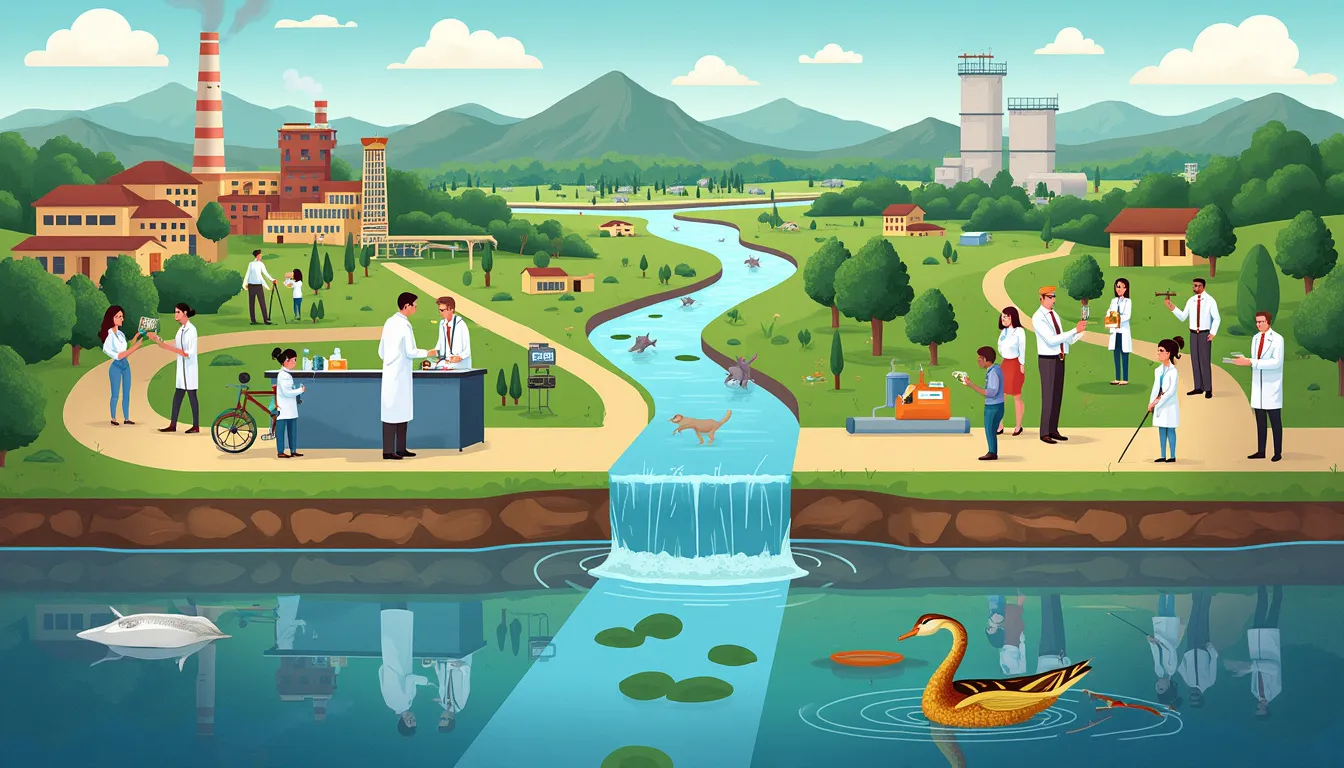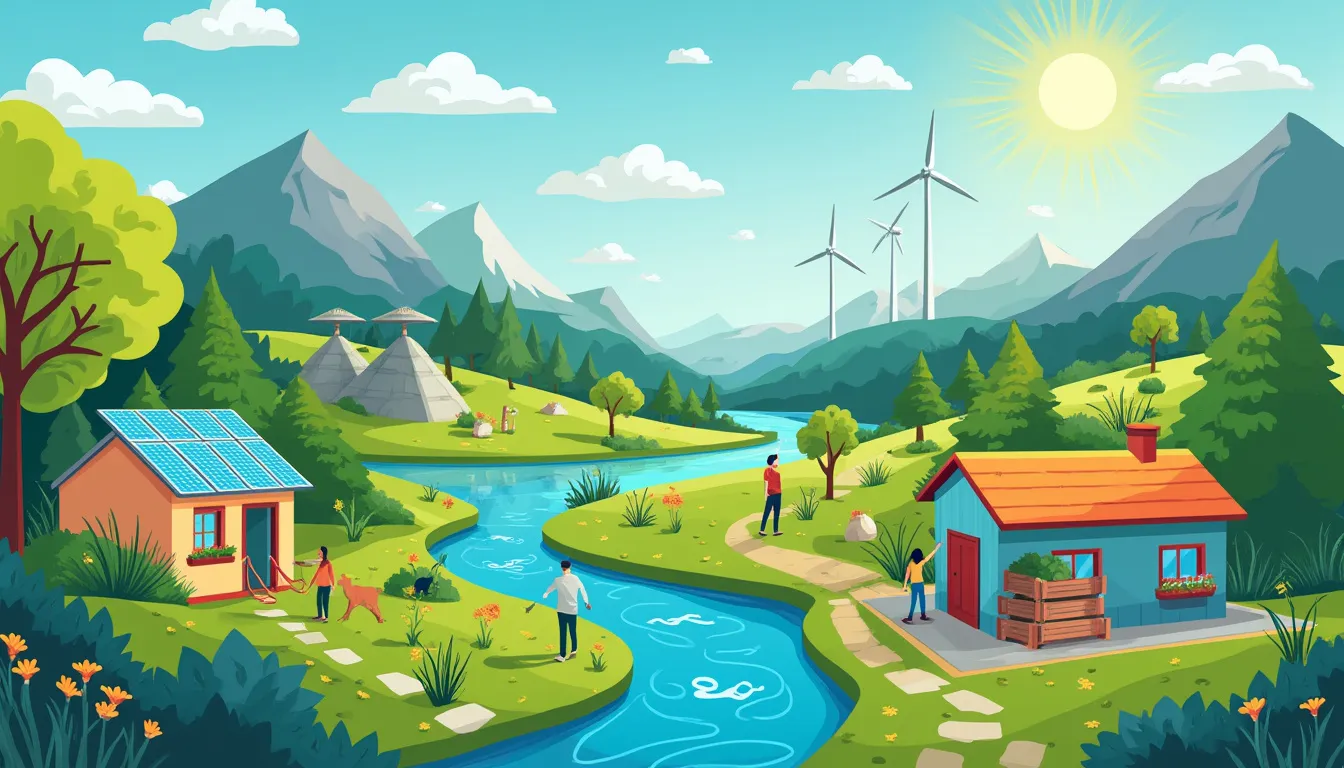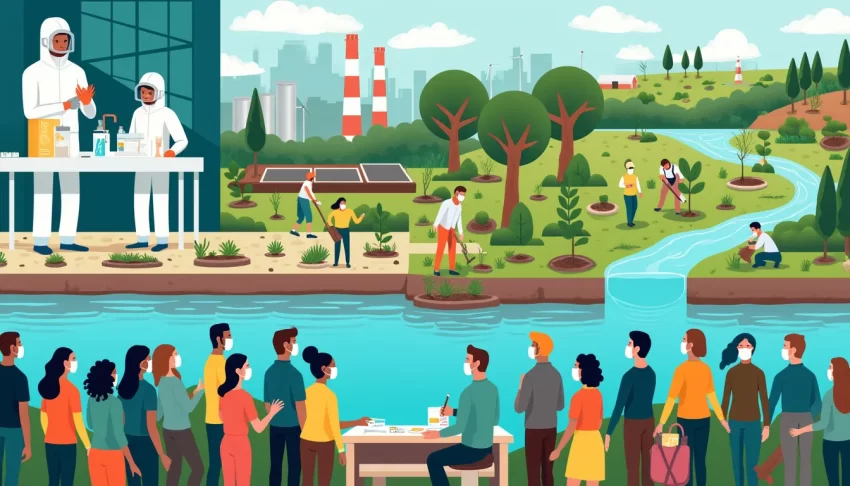When it comes to safeguarding our planet’s health, the Environmental Protection Agency (EPA) plays a pivotal role that’s difficult to overstate. Established in 1970, the EPA was born out of growing public concern for the environment and a pressing need for a dedicated body to oversee environmental protection. As our world grapples with pollution, climate change, and the persistent threat to natural ecosystems, understanding the role of the EPA has never been more essential.
The EPA’s mission is clear: to protect human health and the environment. This mission is pursued through a multifaceted approach that includes the creation and enforcement of regulations, continuous environmental monitoring, and vigorous research initiatives. By maintaining stringent standards for air quality, water safety, and land conservation, the EPA ensures that we, along with future generations, can thrive in a world free from the perils of environmental degradation.
Why should you care about the EPA? Because the agency’s work directly impacts every breath we take, the water we drink, and the land we inhabit. The EPA’s regulations touch various aspects of our daily lives and have a profound influence on public health and safety. For business owners, understanding EPA guidelines is crucial for compliance and for fostering sustainable practices that benefit both their bottom line and the environment.
Whether you’re a concerned citizen curious about reducing your carbon footprint, a business leader aiming to integrate eco-friendly practices, or anywhere in between, exploring the role of the EPA can provide valuable insights and inspire action. The agency’s historical milestones, core responsibilities, and innovative programs underline its fundamental importance in our society. As we dive deeper into the EPA’s functions and challenges, you will gain a greater appreciation of the significant strides made in environmental protection and the continuous journey towards a sustainable future.
Introduction to the Environmental Protection Agency (EPA)
Brief History and Establishment of the EPA
The Environmental Protection Agency, commonly known as the EPA, has been a cornerstone of the United States’ efforts to protect and preserve the environment since its establishment in 1970. The agency was born out of a growing public awareness of environmental issues and a surge in activism during the 1960s. This period saw a rise in concern over the adverse effects of industrialization, pollution, and the decay of natural resources. Events such as the 1969 Santa Barbara oil spill and the Cuyahoga River fire, where the river actually caught fire due to heavy pollution, underscored the urgent need for a federal regulatory body dedicated to environmental protection.
President Richard Nixon, recognizing the need for consolidated efforts, proposed the establishment of the EPA, which was officially created through presidential executive order on December 2, 1970. The agency was tasked with the combined responsibilities of numerous smaller environmental programs under one roof, thereby streamlining and strengthening the nation’s approach to environmental protection.
Overview of the EPA’s Mission and Objectives
At its core, the EPA exists to protect human health and the environment. The agency’s mission encompasses several key objectives aimed at ensuring that all Americans have access to clean air, water, and land, free from harmful pollutants and environmental hazards. This mission is guided by important goals:
– **Ensuring Clean Air and Water**: One of the agency’s primary objectives is to implement policies that reduce air and water pollution. The Clean Air Act and Clean Water Act, landmark laws administered by the EPA, serve as foundational frameworks for these efforts.
– **Reducing Exposure to Toxics**: The agency strives to mitigate the risks associated with toxic chemical exposure by regulating industrial discharges and promoting safer chemical practices.
– **Promoting Environmental Stewardship**: Through various programs and partnerships, the EPA encourages sustainable practices and conservation efforts to safeguard natural resources for future generations.
– **Enforcing Environmental Laws**: Ensuring compliance with environmental regulations is critical to the EPA’s mission. The agency has the authority to enforce laws and take legal action against violators to protect public health and the environment.
Importance of the EPA in Safeguarding Environmental Health
The EPA’s role in environmental protection cannot be overstated. The agency serves as the backbone of the nation’s environmental policy, providing a regulatory framework that balances economic growth with the imperative to preserve natural resources. The importance of the EPA can be illustrated through several key achievements and ongoing efforts:
– **Improving Air Quality**: Since its inception, the EPA has played a pivotal role in significantly reducing air pollution levels. Programs targeting pollutants such as sulfur dioxide and nitrogen oxides have led to notable improvements in air quality, resulting in fewer respiratory illnesses and environmental damage.
– **Protecting Water Resources**: The EPA’s initiatives have vastly improved the quality of drinking water and the health of aquatic ecosystems. By regulating contaminants and enforcing water quality standards, the agency protects critical water resources that are essential for human consumption, agriculture, and wildlife.
– **Mitigating Climate Change**: As climate change becomes an increasingly urgent global issue, the EPA’s efforts in reducing greenhouse gas emissions are crucial. The agency collaborates with industries, states, and international bodies to devise strategies aimed at minimizing climate impacts and promoting clean energy solutions.
– **Advancing Environmental Justice**: The EPA also focuses on addressing the disproportionate environmental burdens faced by marginalized communities. Through its Environmental Justice programs, the agency works to ensure that all communities, regardless of socioeconomic status, have equitable access to a healthy environment.
– **Encouraging Innovation**: The agency’s support for research and development fosters innovative solutions to environmental challenges. By funding scientific studies and promoting technological advancements, the EPA enhances our understanding of environmental issues and accelerates the adoption of sustainable practices.
The EPA’s comprehensive approach highlights its critical role in sustaining not just the environment but also public health and economic well-being. From reducing pollution and conserving resources to advancing policy and advocating for environmental justice, the EPA stands as a guardian of our natural world.

Key Functions and Responsibilities of the EPA
The Environmental Protection Agency (EPA) holds a pivotal role in ensuring that the United States maintains and improves its environmental quality. The agency’s key functions and responsibilities encompass a variety of activities aimed at protecting human health and the environment. Understanding these roles can help individuals and businesses align their practices with national environmental goals. Here, we’ll explore the broad areas where the EPA has a significant impact.
Regulatory and Enforcement Duties
The EPA’s regulatory and enforcement duties are among its most critical functions. This involves creating and enforcing regulations based on laws passed by Congress. For example, the Clean Air Act and the Clean Water Act are foundational pieces of legislation that guide the EPA’s actions.
To enforce these regulations, the EPA conducts inspections, monitors compliance, and takes action against violators. This can include fines, sanctions, or other legal actions to ensure that entities adhere to environmental standards. For instance, in 2020 alone, the EPA enforced laws that resulted in pollution reduction equivalent to taking 1.7 million cars off the road for a year. These efforts ensure that companies and organizations do not compromise environmental health for economic gain.
Development and Implementation of Environmental Laws and Regulations
One of the EPA’s primary responsibilities is the development and implementation of environmental laws and regulations. This includes setting standards for air quality, water quality, and hazardous waste management. The agency works closely with scientists, economists, and public health experts to establish guidelines that protect the environment and public health.
For instance, in response to rising concerns about greenhouse gas emissions, the EPA developed the Greenhouse Gas Reporting Program. This program requires large sources of emissions to report their greenhouse gas levels, providing valuable data that informs policy and regulatory decisions. By leveraging scientific research and public input, the EPA creates regulations that are both effective and feasible.
Monitoring and Research Initiatives to Track Environmental Quality
Monitoring and research are foundational to the EPA’s mission. The agency conducts extensive research to understand environmental issues and develop innovative solutions. This research often focuses on emerging environmental threats, such as microplastics in waterways or the impact of pesticides on pollinators.
One key initiative is the National Air Toxics Assessment (NATA), which evaluates air pollution levels and their potential health effects. By collecting and analyzing data from monitoring stations across the country, the EPA can identify trends and hotspots that require attention. These insights are crucial for developing targeted policies and interventions.
In addition to its own research, the EPA collaborates with academic institutions, non-profit organizations, and other government agencies. This collaborative approach enhances the scope and impact of environmental research, ensuring that the latest scientific findings inform policy and regulatory decisions. For example, partnerships with universities have led to breakthroughs in understanding the environmental and health impacts of PFAS (per- and polyfluoroalkyl substances), often referred to as forever chemicals due to their persistence in the environment.
Personal Reflection: The Impact of Research on Everyday Life
Having grown up near a factory town, I’ve seen firsthand how industrial activities can affect local air and water quality. EPA’s ongoing research and monitoring efforts play a critical role in highlighting these impacts, driving both local and national efforts to improve environmental conditions. For example, the agency’s studies on water contamination have directly influenced improvements in our local water treatment facilities, ensuring cleaner, safer water for all residents.
The EPA’s regulatory, enforcement, and monitoring responsibilities are crucial for maintaining the United States’ environmental health. By understanding these functions, one can appreciate the comprehensive efforts required to protect our natural resources and ensure a sustainable future. These responsibilities not only involve curbing pollution but also fostering innovation and public awareness, ultimately leading to a healthier planet.

### Major Programs and Initiatives Led by the EPA
When it comes to safeguarding our environment, the EPA (Environmental Protection Agency) stands at the forefront with numerous programs aimed at ensuring cleaner air, water, and soil. The EPA’s programs and initiatives are diverse, extensive, and pivotal in mitigating the impacts of environmental hazards on public health and ecosystems.
#### Notable EPA Programs: Clean Air Act and Clean Water Act
One of the most significant endeavors undertaken by the EPA involves the Clean Air Act (CAA) and the Clean Water Act (CWA). These landmark legislations have reshaped the American environmental landscape for the better.
**Clean Air Act (CAA)**
The Clean Air Act, originally passed in 1963 and significantly amended in 1970, 1977, and 1990, plays a critical role in reducing air pollution. The EPA, through this Act, has set standards for pollutants like sulfur dioxide, nitrogen oxides, and particulate matter, which are known to harm human health and the environment. Since its implementation, the CAA has substantially decreased pollutants, contributing to improvements in public health, prevention of respiratory illnesses, and the preservation of natural habitats.
**Clean Water Act (CWA)**
Similarly, the Clean Water Act governs water pollution by establishing quality standards for surface waters. Passed in 1972, the CWA has enabled the EPA to implement pollution control programs that have been instrumental in reducing the contamination of rivers, lakes, and streams. Through strict permitting processes and rigorous enforcement, the EPA has worked to ensure that our waterways remain safe for recreation, wildlife habitats, and as sources of drinking water.
#### Efforts in Addressing Climate Change and Pollution Control
The EPA is also at the helm of national efforts to combat climate change and reduce pollution. The agency implements various programs designed to mitigate greenhouse gas emissions and promote cleaner energy sources.
**Climate Change Initiatives**
The EPA’s climate change initiatives are multifaceted and include regulatory measures, research, and community outreach. For instance, the Clean Power Plan aimed at reducing carbon pollution from power plants represents an ambitious step towards curbing climate change. Additionally, the EPA collaborates with industries, utilities, and state governments to transition towards more sustainable practices and renewable energy sources.
**Pollution Control Programs**
The EPA’s pollution control programs encompass a wide array of activities focused on reducing pollutants from sources such as industrial facilities, vehicles, and agricultural operations. Initiatives like the National Ambient Air Quality Standards (NAAQS) ensure that outdoor air meets health-based criteria. By continuously monitoring air quality and adopting stricter pollution controls, the EPA helps communities breathe cleaner air.
#### Community and Public Engagement Through Education and Resources
One of the less frequently highlighted but equally important aspects of the EPA’s work is its emphasis on public engagement and education. The EPA recognizes that empowering communities with knowledge and resources is key to fostering sustainable practices and environmental stewardship.
**Educational Outreach Programs**
The EPA runs several educational outreach programs aimed at various audiences ranging from school children to business owners. Programs like ‘It’s Our Environment’ and ‘AirNow’ provide valuable information about maintaining a healthy environment and understanding air quality indices. Such initiatives cultivate an informed public, well-equipped to make decisions that favor environmental well-being.
**Community Resources and Grants**
Moreover, the EPA offers a plethora of resources, including grants, to support community-based environmental projects. These grants fund initiatives such as brownfield cleanups, local pollution prevention, and urban tree planting, which enhance community resilience and ecological health. By involving local entities in these projects, the EPA ensures that environmental protection becomes a collective effort.
The EPA’s extensive range of programs and initiatives exemplifies its commitment to protecting the environment. From landmark legislations like the Clean Air Act and Clean Water Act to innovative climate change strategies and community engagement efforts, the EPA plays a crucial role in fostering a sustainable future. As we look towards a cleaner, healthier planet, these initiatives highlight the vital importance of coordinated action and informed public participation.

Challenges and Future Directions for the EPA
Current and Emerging Environmental Challenges Facing the EPA
The Environmental Protection Agency (EPA) is continually grappling with a host of environmental challenges, many of which are increasing in complexity and urgency. One of the most prominent issues is climate change. The EPA must address the multifaceted impact of global warming, which includes more frequent extreme weather events, sea-level rise, and shifts in ecosystems. According to the National Oceanic and Atmospheric Administration (NOAA), the United States alone experienced 22 weather and climate disasters in 2020 with losses exceeding $1 billion each. These events underscore the necessity for vigorous climate strategies spearheaded by the EPA.
Another significant challenge is pollution. Despite progress over the years, air, water, and soil pollution remain dire threats to public health and environmental quality. The American Lung Association reports that over 40% of Americans live in areas with unhealthy air quality. Persistent pollutants, such as plastics and hazardous waste, continue to contaminate ecosystems, affecting both wildlife and human populations.
Moreover, emerging issues like the proliferation of new chemicals and technologies pose fresh challenges. The EPA is tasked with evaluating the potential environmental and health impacts of thousands of existing and new chemicals, requiring advanced scientific methodologies and substantial resources. The rise of electronic waste and nanomaterials also presents uncharted territory for regulatory frameworks, pressing the EPA to stay ahead of these developments.
Policy Debates and Legislative Changes Impacting the EPA’s Role
The EPA operates within a complex web of policy debates and legislative changes that influence its ability to fulfill its mission. Political shifts can significantly impact the agency’s regulatory priorities and funding. For instance, changes in administration can lead to varying levels of support for environmental regulations. During different administrations, there have been stark contrasts in how the EPA approaches issues like climate change and pollution control, often resulting in policy reversals and regulatory uncertainty.
In recent years, debates around the balance between economic growth and environmental protection have been particularly pronounced. Some argue that stringent regulations can hamper business operations and economic development, advocating for more relaxed environmental standards. Conversely, proponents of robust environmental regulations emphasize the long-term benefits of preserving natural resources and public health, advocating for the EPA to maintain strong regulatory measures.
Legislative actions also shape the EPA’s role. New laws and amendments to existing environmental statutes can expand or contract the agency’s regulatory scope. For example, amendments to the Clean Air Act or the Clean Water Act can enhance the EPA’s ability to enforce pollution controls or introduce new challenges. The ongoing legislative process requires the EPA to be adaptable and proactive in responding to policy changes.
Vision for the Future: Enhancing the EPA’s Effectiveness in Environmental Protection
Despite these challenges, there are numerous opportunities for the EPA to enhance its effectiveness in environmental protection. One critical avenue is leveraging technology and innovation. By adopting advanced monitoring systems, the EPA can improve the accuracy and efficiency of environmental data collection. Technologies such as remote sensing, artificial intelligence, and big data analytics can enhance the agency’s ability to identify pollution sources, predict environmental trends, and enforce regulations more effectively.
Community engagement and public education also play pivotal roles in the EPA’s future. Empowering local communities with information and resources can foster greater public participation in environmental protection efforts. Initiatives like citizen science programs, where ordinary citizens contribute to data collection and environmental monitoring, can broaden the EPA’s reach and impact.
Furthermore, enhancing collaboration with other agencies, non-governmental organizations, and international partners is essential. Environmental challenges are often cross-border and multi-faceted, requiring coordinated efforts for effective solutions. By building strong partnerships, the EPA can leverage external expertise, share best practices, and align efforts with global environmental goals.
Finally, ensuring adequate funding and resource allocation is fundamental to the EPA’s long-term success. Securing sustained financial support enables the agency to invest in research, adopt new technologies, and expand its regulatory capabilities. Advocacy for robust budget allocations and legislative backing is crucial for empowering the EPA to tackle the pressing environmental issues of our time.
In conclusion, while the EPA faces significant challenges, the path forward is paved with opportunities for innovation, collaboration, and enhanced public engagement. By addressing emerging environmental threats and navigating complex policy landscapes, the EPA can continue to play a vital role in safeguarding our environment for future generations.
As we’ve explored, the Environmental Protection Agency (EPA) plays a pivotal role in maintaining and enhancing environmental health. Established in 1970, the EPA was born out of a growing public demand for cleaner air, water, and land. Its mission is clear: to protect human health and the environment through rigorous science, policy, and enforcement.
The EPA’s responsibilities are vast and varied. They serve as both regulator and enforcer, ensuring compliance with environmental laws like the Clean Air Act and the Clean Water Act. Through its monitoring and research efforts, the EPA tracks environmental quality, identifies emerging threats, and fosters data-driven decision-making. Indeed, the agency’s work in crafting and implementing environmental regulations sets the standard for sustainability nationwide.
Programs spearheaded by the EPA have brought significant environmental improvements. The Clean Air Act, for instance, has dramatically reduced air pollution, while initiatives addressing climate change and pollution control are instrumental in tackling some of today’s most pressing environmental issues. Equally important is the EPA’s commitment to community engagement, educating the public, and providing resources to help citizens and businesses make sustainable choices.
However, the path forward is fraught with challenges. Environmental concerns like climate change, pollution, and emerging contaminants require adaptive and forward-thinking strategies. Policy debates and legislative shifts often impact the scope and efficacy of the EPA’s work. Despite these hurdles, the EPA remains essential for steering national and global efforts in environmental protection.
Looking to the future, the EPA’s vision must be one of resilience and innovation. Enhancing the agency’s effectiveness means leveraging advanced technologies, fostering cross-sector collaboration, and advocating for robust environmental policies. Both individuals and businesses have a role to play in supporting the EPA’s mission. By adopting sustainable practices, engaging in informed dialogue, and advocating for strong environmental protections, we can collectively contribute to a healthier, more sustainable planet.
So, whether you’re at home or running a business, remember that sustainability starts with informed choices and proactive efforts. The EPA’s work underscores the importance of preserving our environment not just for today, but for generations to come. Let’s all take a leaf out of the EPA’s book and commit to protecting the natural world that sustains us.
Support Us: Check out our recommended products on Amazon.

